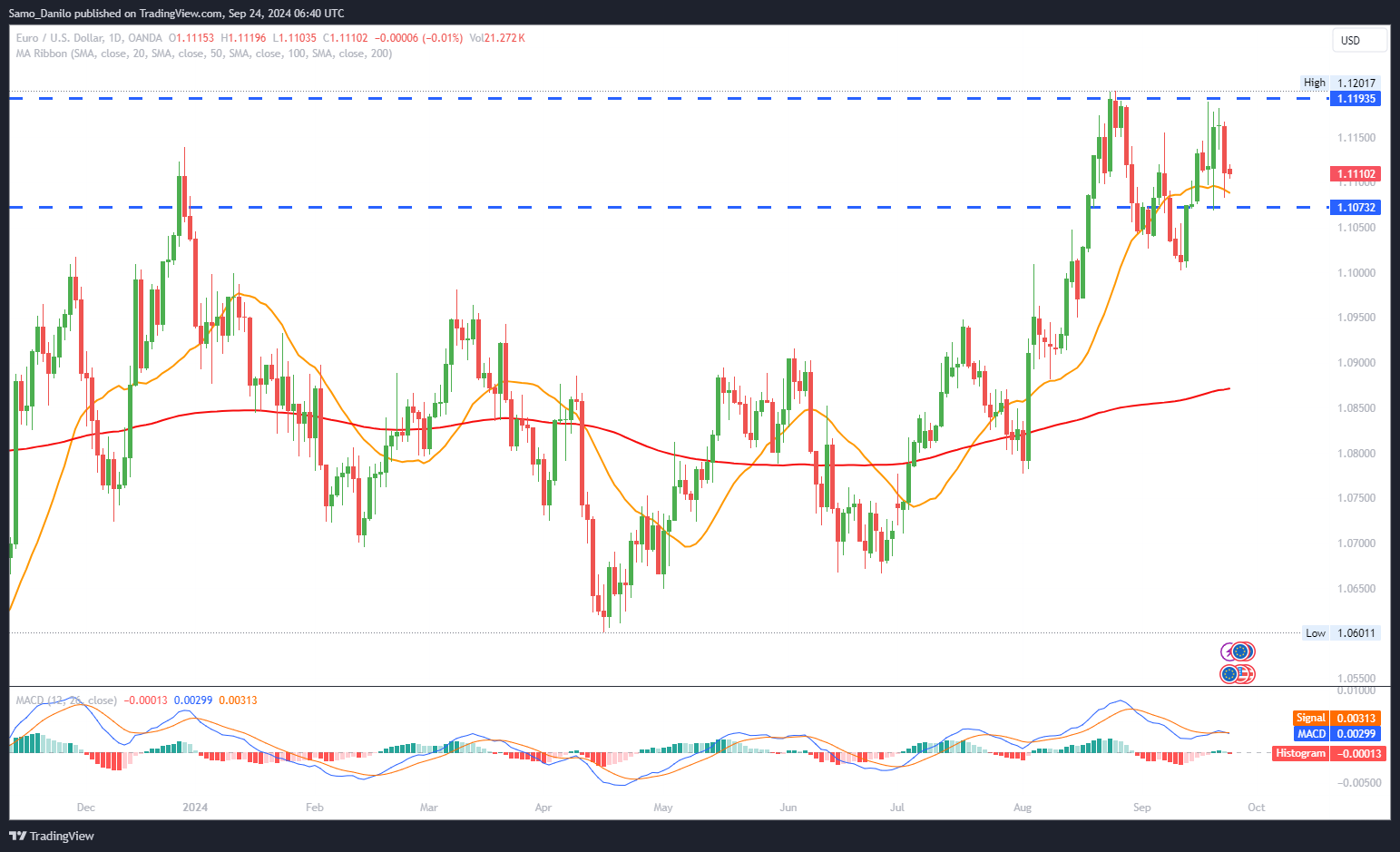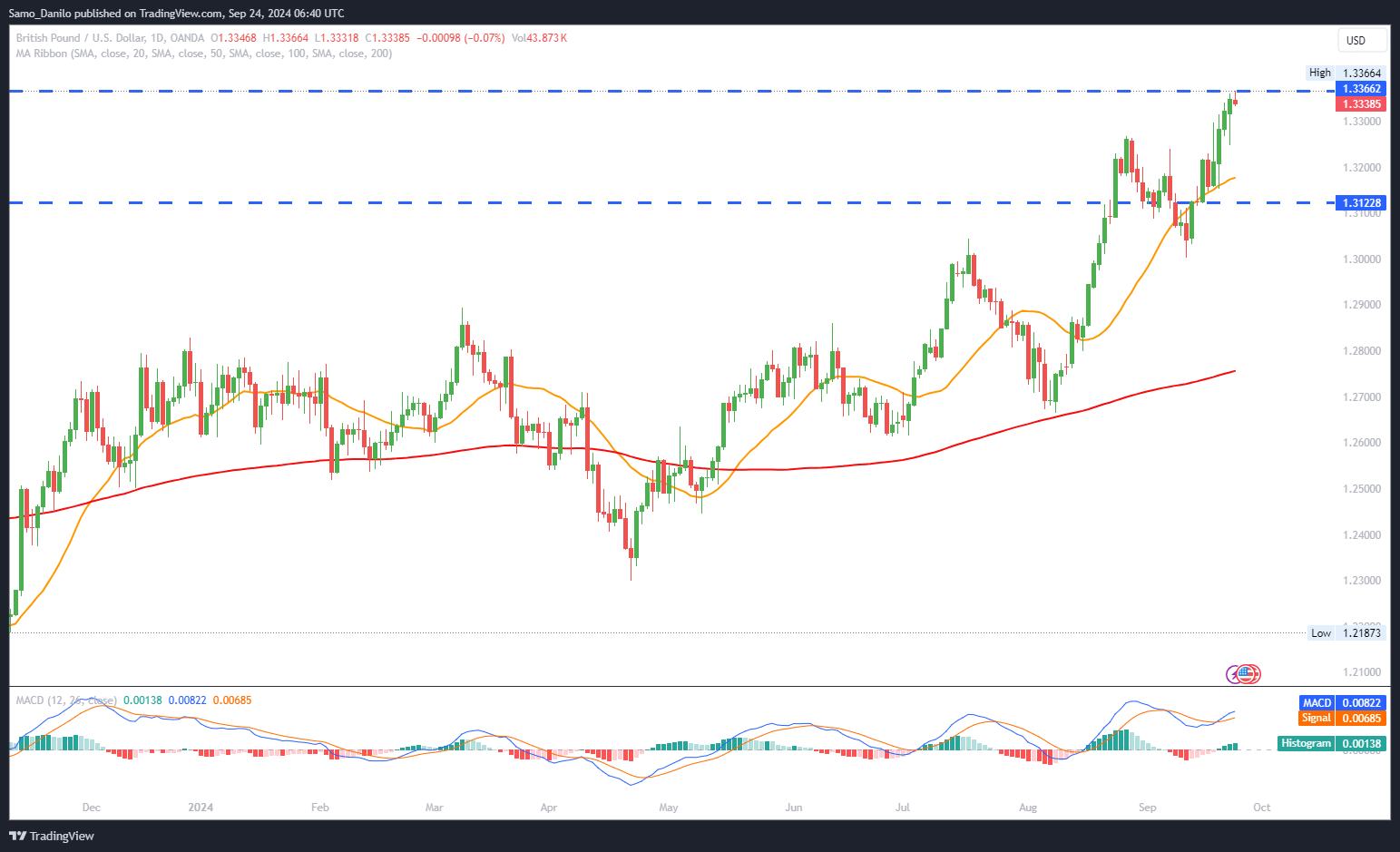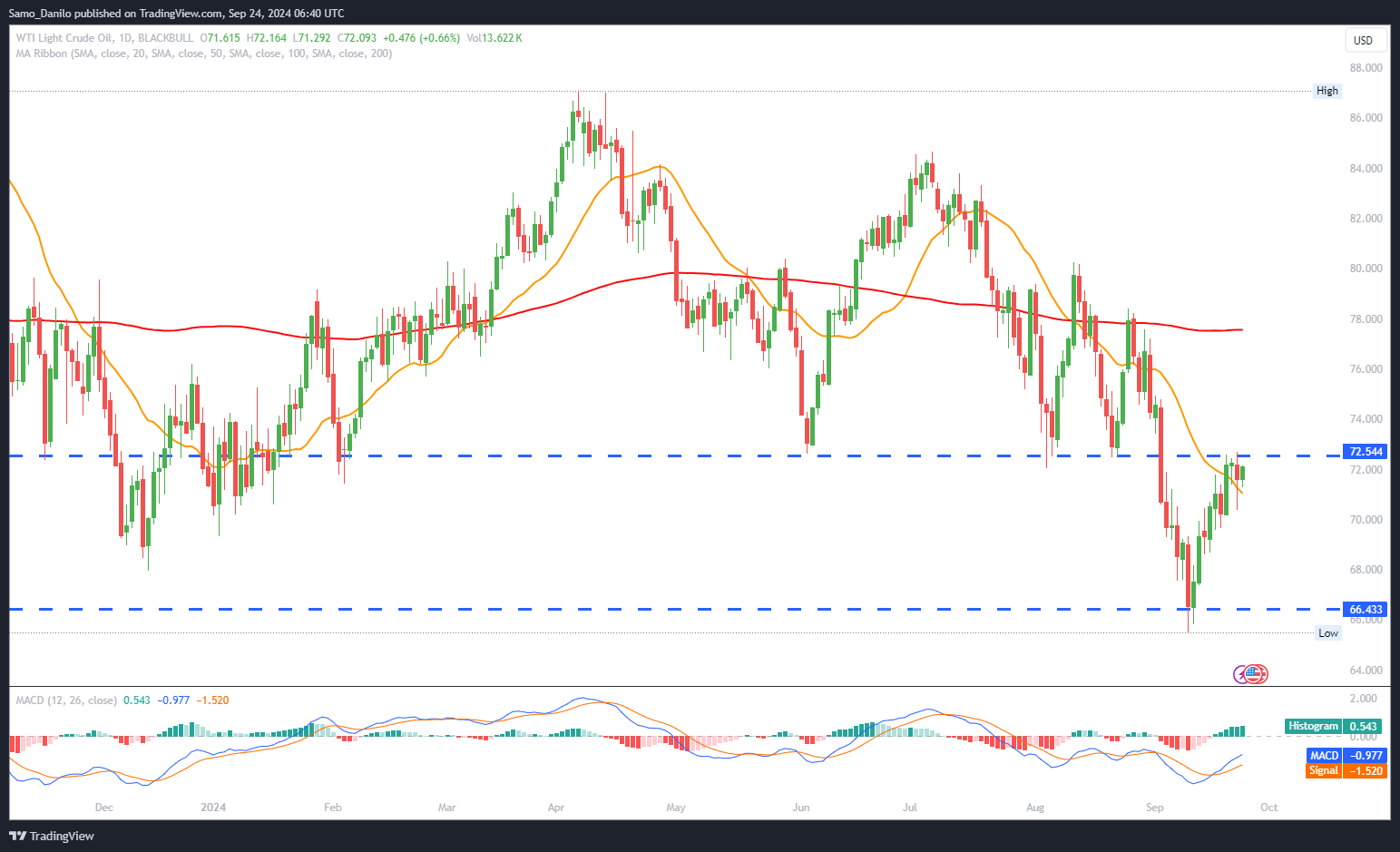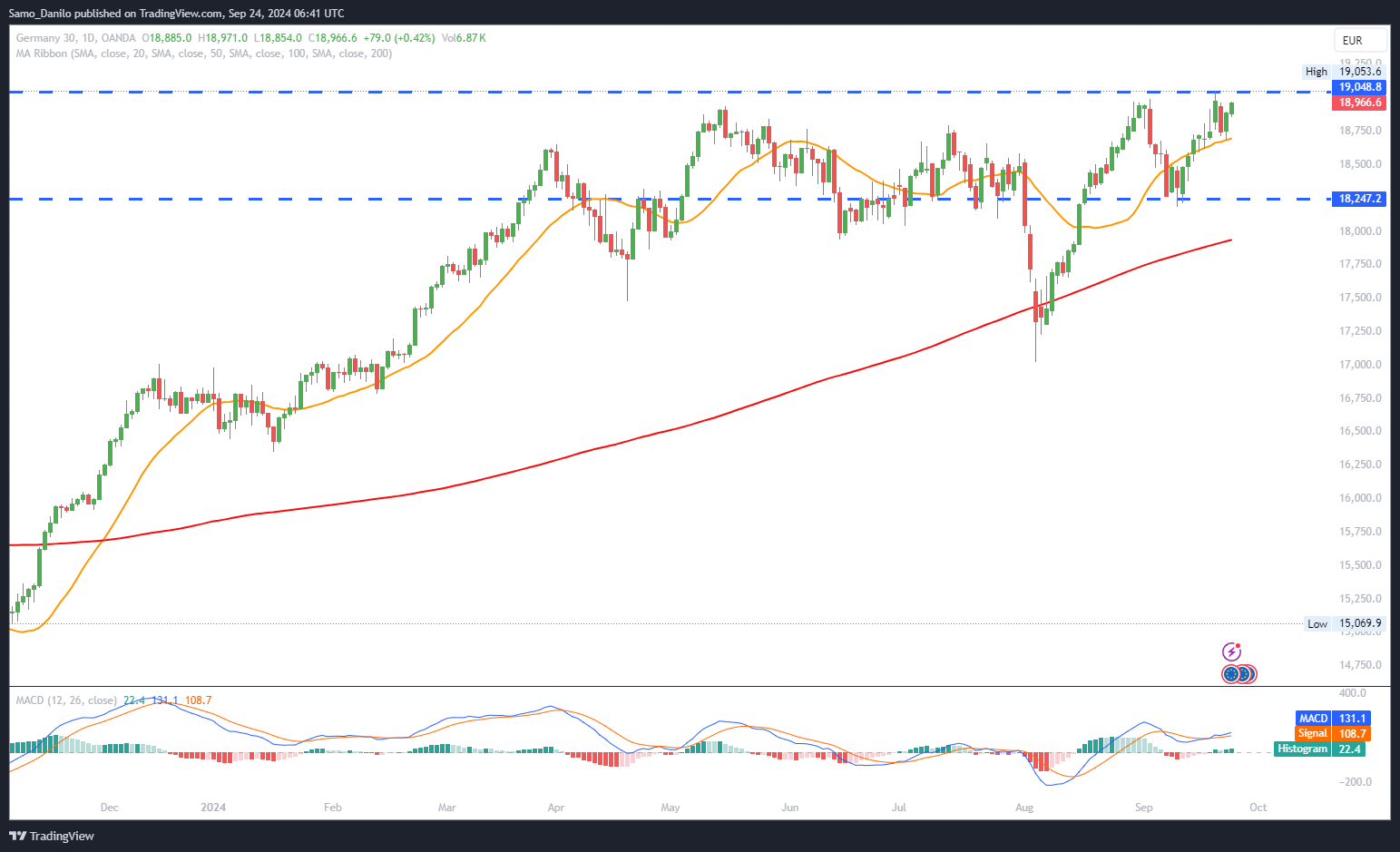EURUSD
- EUR/USD Performance: The EUR/USD pair reversed some of its recent gains, dropping by 0.5% on Monday as economic concerns in the Eurozone resurfaced, while US economic activity remained strong. This shift in momentum highlights the diverging economic paths between the Eurozone and the United States.
- Eurozone PMIs: Flash estimates from the Hamburg Commercial Bank (HCOB) revealed that September Purchasing Managers Indexes (PMIs) continue to signal an economic setback in the Eurozone. The data showed that the German economy slipped further into contraction, with the German Composite PMI falling to 47.2 from 48.4 in August, marking the fourth consecutive monthly decline. Additionally, the Eurozone Composite PMI also weakened to 48.9, significantly below the expected 50.6, with the manufacturing sector suffering the most.
- US PMIs: In contrast, S&P Global's preliminary estimates for US PMIs showed that business activity growth remained robust in September, further boosting the US Dollar (USD) and widening the economic gap between the US and the Eurozone. The relative strength of the US economy continues to support the greenback.
- Upcoming Euro Data: On Tuesday, the focus in the Eurozone will be on Germany’s IFO Survey on Business Climate, which could provide further insight into economic sentiment.
- Upcoming US data: Meanwhile, in the US, traders will closely watch the September CB Consumer Confidence data, which could influence Fed rate expectations and the future trajectory of the USD.
Closing statement: The EUR/USD pair faces downside pressure as the Eurozone grapples with a weakening economy, while the US continues to show resilience in its economic performance. The pair's near-term direction will depend on key data releases, particularly Germany’s IFO survey and US Consumer Confidence. Should the Eurozone's economic outlook deteriorate further, and US data remain strong, the EUR/USD could extend its decline. However, any sign of improvement in German sentiment or softer US data could provide relief to the Euro.
GBPUSD
- GBP/USD Performance: The GBP/USD pair continues to extend its winning streak for the fifth consecutive session, trading around 1.3350 during Tuesday’s European session. The pair has maintained an upward momentum amid a softer US Dollar (USD) and lingering expectations of further rate cuts from the US Federal Reserve (Fed).
- UK Manufacturing PMI: On the data front, the preliminary UK Manufacturing PMI for September came in at 51.5, falling from 52.5 in August and missing market expectations of 52.3. The lower-than-expected reading raises concerns over the strength of the UK manufacturing sector, signalling slower growth and potential economic headwinds.
- Economic Concerns: UK Prime Minister Keir Starmer expressed concerns about the UK’s economic trajectory, warning that the domestic economy may be heading toward "painful" reforms. Such a statement could add caution to the market regarding the UK's economic outlook, weighing on investor sentiment in the near term.
- US Federal Reserve Comments: Comments from Federal Reserve officials on Monday further supported the GBP/USD pair. Minneapolis Fed President Neel Kashkari stated that he expects additional rate cuts in 2024, reinforcing the market's dovish outlook on US monetary policy. Similarly, Chicago Fed President Austan Goolsbee suggested that "many more rate cuts" are likely over the next year, pushing the USD lower and benefiting the GBP.
| SMA (20) | Rising |
|
|
| RSI (14) | Rising |
|
|
| MACD (12, 26, 9) | Rising |
|
|
Closing statement: The GBP/USD pair remains buoyed by the prospect of more Fed rate cuts and economic concerns surrounding the US Dollar. However, downside risks could emerge if the UK economic data deteriorates further or if global risk sentiment sours. Investors will also keep an eye on upcoming data releases, including the UK Services PMI, which could provide more insight into the broader economic outlook. Overall, the GBP/USD may continue to climb in the short term, but potential headwinds from both the UK and global economies should not be ignored.
GOLD
- Gold Price Movement: Gold (XAU/USD) has pulled back slightly from its new record high of $2,635 early on Tuesday, mirroring the price action seen during Monday’s European session. Despite the slight retreat, gold remains supported by ongoing market dynamics, particularly amid geopolitical tensions and dovish monetary policies.
- PBOC Stimulus Measures: At a highly anticipated press conference, the People’s Bank of China (PBOC) Governor Pan Gongsheng announced a series of measures to stimulate the economy, including plans to cut the reserve requirement ratio (RRR) by 50 basis points (bps). This move is aimed at supporting China's economic recovery, but the central bank's actions also reflect the challenges the Chinese economy continues to face, providing additional support for gold as a safe-haven asset.
- Middle East Tensions: On the geopolitical front, Bloomberg reported that Israel intensified its airstrikes in southern Lebanon, following a weekend of missile exchanges between Israel and Hezbollah. The escalating conflict in the Middle East could expand into a broader regional conflict, boosting demand for safe-haven assets like gold.
- Fed Rate Hike Speculation: Despite expectations for another 50-bps rate hike by the US Federal Reserve in November, dovish rhetoric from Fed policymakers continues to lend support to gold prices. Traders remain optimistic that future rate hikes may be less aggressive, which has tempered the US Dollar (USD) and further fueled gold’s appeal.
- Upcoming Data: Investors are eagerly awaiting fresh speeches from Fed officials and the release of the US Consumer Confidence data. These events are expected to provide further clues on the Fed’s policy direction and could influence traders’ outlook for gold prices in the short term.
| SMA (20) | Rising |
|
|
| RSI (14) | Rising |
|
|
| MACD (12, 26, 9) | Rising |
|
|
Closing statement: Gold remains well-positioned near its all-time high, benefiting from geopolitical instability and the dovish stance of major central banks. The escalating Middle East tensions and China's economic recovery efforts provide a solid base for further upside. However, gold traders should keep a close eye on US economic data and Fed communications in the coming days, as they could either strengthen the bullish case or trigger a correction in XAU/USD.
CRUDE OIL
- Price Movement: West Texas Intermediate (WTI) crude oil is trading within a tight range, just above the mid-$70.00s during the Asian session on Tuesday, maintaining proximity to a nearly three-week high reached in the previous session. The commodity’s price action reflects cautious optimism amid supply concerns, tempered by global economic worries.
- Middle East Tensions: The continuation of Israel's airstrikes against Iranian-backed Hezbollah sites in Lebanon on Monday has heightened the risk of a broader conflict in the Middle East, which could disrupt oil supplies from the region. Geopolitical instability has been a key driver of oil prices, pushing them higher due to concerns over potential supply shortages.
- US Dollar Impact: The US Dollar (USD) struggles to extend its recent rebound from its year-to-date low, which followed the Federal Reserve's jumbo interest rate cut last week. The USD’s subdued performance has limited its impact on oil prices, as a weaker dollar typically makes crude more affordable for international buyers, supporting demand.
- Economic Outlook: Despite the geopolitical risks, the upside for oil prices remains capped by concerns over the global economic outlook. The Eurozone flash PMIs released on Monday painted a grim picture, showing a sharp and unexpected contraction in business activity in September, which has raised fears of a slowdown in oil demand.
- Upcoming Events: Oil traders are closely watching speeches from influential Federal Open Market Committee (FOMC) members, as well as the release of the US Personal Consumption Expenditures (PCE) Price Index on Friday. These events are expected to offer further insight into the US Federal Reserve's future monetary policy stance, which could influence the US Dollar and, by extension, oil prices.
| SMA (20) | Falling |
|
|
| RSI (14) | Slightly Rising |
| |
| MACD (12, 26, 9) | Slightly Rising |
|
Closing statement: While WTI crude oil prices remain supported by Middle East tensions and the weaker US Dollar, the market is cautious due to a worsening global economic outlook. Traders should pay attention to US economic data and Fed speeches later this week, as these could dictate the next move in oil prices, either reinforcing the current bullish sentiment or capping further gains amid demand concerns.
DAX
- Market Movers: On Monday, Zalando SE surged 3.17%, leading the DAX gains, while Siemens Energy AG advanced 2.88% amid rising bets for a European Central Bank (ECB) rate cut in Q4 2024. Expectations of lower borrowing costs boosted auto stocks, with BMW climbing 2.44%, while Volkswagen and Mercedes-Benz Group gained 2.14% and 2.00%, respectively.
- PMI Weakness Fuels Rate Cut Hopes: The private sector PMI data from Germany released on Monday increased speculation of an ECB rate cut later this year. The HCOB Manufacturing PMI dropped from 42.4 in August to 40.3 in September, marking a 12-month low. The sharp decline reflects ongoing weakness in the German manufacturing sector, indicating softer demand and potentially warranting policy intervention by the ECB to stimulate the economy.
- Upcoming Ifo Business Climate Index: Investors are eyeing the Ifo Business Climate Index, set for release on Tuesday. Analysts expect the Index to dip from 86.6 in August to 86.1 in September, which would further confirm the current economic challenges facing Germany.
- US Services PMI: The US S&P Global Services PMI on Monday reassured markets by showing a slight decline, from 55.7 in August to 55.4 in September, easing fears of a severe US economic slowdown.
- Upcoming US Data: Tuesday’s US Consumer Confidence Index will be in focus, with expectations for a modest improvement from 103.3 in August to 103.8 in September. A positive reading could provide relief to global markets and support risk sentiment.
| SMA (20) | Rising |
|
|
| RSI (14) | Rising |
|
|
| MACD (12, 26, 9) | Rising |
|
|
Closing statement: The DAX appears buoyant, supported by strong performances in tech and auto stocks, fuelled by hopes for an ECB rate cut in Q4 2024. However, weakening economic data, especially in the German manufacturing sector, may prompt further policy easing, which could lend additional support to equities. Traders will closely monitor the Ifo Business Climate Index and US Consumer Confidence figures for potential impacts on broader market sentiment and the DAX's short-term direction.




